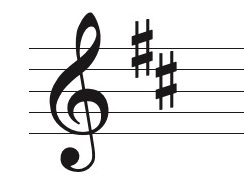10 Major Key Signatures
Major Key Signature for Sharps

When identifying or trying to memorize the major key signatures that have sharps in them, a useful “trick” is to look at the last sharp added (meaning the sharp found on the farthest right of the key signature) and go up one semitone. The note found one semitone above the last sharp added will always be the name of the major scale associated with that key signature.
Example

For example, in the key signature with 2 sharps, the C♯ is the furthest to the right. One semitone higher than C♯ is D, and D major is the correct major scale.
The sharps appear in a specific order and position in the key signature. A mnemonic device is used to help remember the order of the sharps. This can be helpful when writing a key signature down by hand or for quickly remembering which notes are sharp in a key signature. The mnemonic device is:
Father
Charles
Goes
Down
And
Ends
Battle
Major Key Signature for Flats
For major key signatures that have flats, the flats and the order of the flats differ from the sharps.

There is, again, a mnemonic device and “trick” that can be helpful in identifying and memorizing the key signatures with flats.
Battle
Ends
And
Down
Goes
Charles’
Father
As B♭, E♭, A♭, D♭b, G♭, C♭, then F♭ appear in that order, the mnemonic device above can be used to help remember the order in which they appear. It can also be used to identify or create a key signature. The flats in a major key signature are always (almost) one flat past the name of the key, using the mnemonic device. For example, when trying to remember the key signature for A♭ major, we would say the “trick” one past the A. Battle Ends And Down – D is one past the A in the device, so the key signature would be four flats. The exception is F major, as there is only one flat. Similarly, when trying to identify a key signature, we can look at the second last flat added, and that will be the key – with the exception again of F major as it only has one flat.
Exercise

